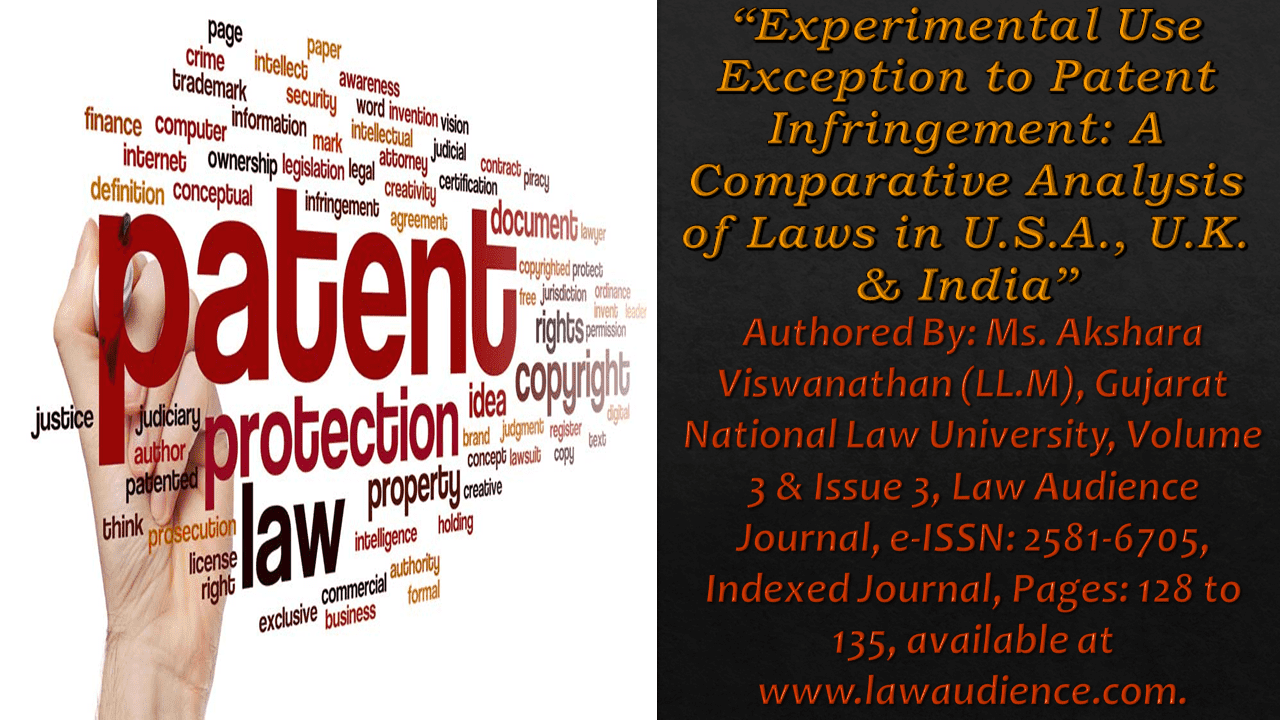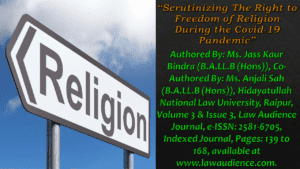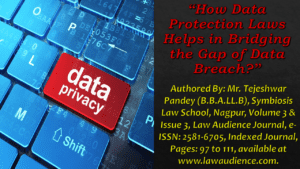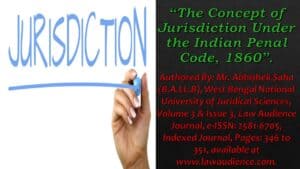Click here to download the full paper (PDF)
Authored By: Ms. Akshara Viswanathan (LL.M), Gujarat National Law University,
Click here for Copyright Policy.
ABSTRACT:
“As a consequence of globalization, the relevance of the patent system has increased significantly. The patent regime grants the inventor exclusive rights for a fixed period of time, so as to enable him to enjoy the fruits of his skill and labour thereby encouraging more people to contribute. It is a quid-pro-quo incorporated in the patent system that the inventor is given exclusive right to make, sell, use, and offer the patented invention for sale or import in return of disclosure of his invention to the public. There are few exceptions to this right and experimental use exception is one among them.
The main aim of patent system being development of science and technology, experimental use exception becomes very significant since it paves way for more people to contribute without constituting an infringement. However this exception, which gives societal access to the patented invention, and the exclusive right given to the patentee to exclude others, has a direct conflict in between. Patent law tries to solve this conflict by balancing the rights of the patent holder, third parties, and the public.
The law governing this is not clear in many countries as they are still struggling to draw a line between the exclusive rights of patent holder and exemptions granted for research. Depending upon the social conditions and needs of a country, and the ideologies followed by them, the scope of research exemption differs from country to country. This paper discusses the scope of experimental use exception for patent infringement and also contains a comparative analysis of the law in various jurisdictions across the world. The paper concludes by suggesting the Indian Government to have a re-look at the patent legislation and to clear the ambiguities by broadening the scope of exception”.
Keywords – Patent, infringement, experimental use exception, Hatch-Waxman exemption, research exemption, Bolar exemption, TRIPS Agreement.
I. INTRODUCTION:
The Agreement on Trade-Related Aspects of Intellectual Property Rights (TRIPS Agreement) is the most exhaustive multilateral agreement on intellectual property and trade. It is focussed on universal standards for IP protection and their enforcement. It has brought about a lot of significant changes in the IP laws around the world. The reason is that once a country becomes a member of TRIPS, it becomes necessary for it to make certain changes in its IP laws to comply with the provisions of the TRIPS Agreement. Exclusive patent rights are granted as a reward to the patentees for contributing to the production of knowledge, the ultimate aim being the protection of intellectual property in trade. However, this does not always enhance the public welfare but may also act as a disadvantage. Thus, certain limitations and exceptions are set to patent rights so that the interests of the patent holders, third parties, and the public are well balanced.
Ever since India became a signatory to the TRIPS Agreement, changes have been brought about to its IP laws as well. Amendments were made to the law governing patents in India, the Patent Act, 1970 in order to bring it in conformity with the TRIPS Agreement and limitations and exceptions to patent rights as per the norms of the agreement were introduced into the legislation from time to time. These exceptions and limitations vary from country to country depending on their socio-economic conditions and priorities.
Article 30 of the TRIPS Agreement talks about the right of member states to set limited exceptions while granting patent rights according to their discretion, provided that they do not unreasonably conflict with normal exploitation of the patent and must not unreasonably prejudice the legitimate interests of the patent owner taking into account the legitimate interests of the third parties. However, it is a vague and very general provision as it does not talk about what the legitimate interests of the patent owner or the third parties are. Thus, the exceptions to the patent laws are not uniform throughout the member states, especially with regard to the experimental use exception. The limitations and exceptions to patent infringement in India as per the Patent Act, 1970 are: (i) experimental or research use; (ii) use of patented invention on foreign vessels etc.; (iii) for obtaining regulatory approval from authorities; (iv) exhaustion of patent rights & parallel imports; (v) compulsory licensing and (vi) use or acquisition of inventions by government.
II. WHAT IS AN EXPERIMENTAL USE EXCEPTION?
A key purpose of the patent system is the dissemination of the knowledge and advancement of technology. Any rider preventing the experimental use of patent would defeat the purpose of the disclosure and will be contrary to public policy. The experimental use exception in the US grew out of the opinion of Story J in Whittemore vs. Cutter.[1] Story J stated, “It could never have been the intention of the legislature to punish a man who constructed such a machine merely for philosophical experiments or for the purpose of ascertaining the sufficiency of the machine to produce its described effects.” Research exception is also known as the Hatch-Waxman exemption in the US while in Canada, it is known as the Bolar provision.
A researcher uses various sciences and technologies, patented or unpatented while conducting experiments. Generally, a person dealing with patented products or processes are required to take a prior license. This requirement acts as a hindrance in the progress of science and technology in case of experimental uses. This is because, when a researcher is required to take a license for all the patented products and processes he is working on, it consumes time and cost and is therefore practically very difficult. The main objective of patent law being the progress of science and innovation, it is necessary to have experimental use exception for the ease of researchers engaged in research and development activity. Experimental use exception of patents has gained its place in most of the jurisdictions, but its scope is not well settled. The main problem in this is regarding whether the experimental use exception would include researches undertaken for commercial purposes. In this era in which most of the organizations undertake experiments for commercial purposes, the scope of the experimental use exception is of extreme importance. Thus, we can undoubtedly say that the future of research-based industries like engineering, biotechnology, pharmaceuticals, and computers is dependent on the scope of interpretation of the experimental use exception in patent laws.
III. POSITION IN UNITED STATES:
US experimental use exception can be divided into two, the first one being the common law exception and the second one being statutory exception relating to drugs and medical devices as provided under Section 271(e) (1) of 35 USC Patent Act.
As already discussed above, it was in the US case law Whittemore vs. Cutter[2], that the experimental use exception was first identified by the court. Justice Story, in this case, stated that when a patented product is made or used as an experiment without an intent to use for profit, it will not constitute a patent infringement, regardless of whether it is done for gratification of scientific tastes, curiosity, or to ascertain the verity and exactness of the specification or for amusement. Justice Story also added that punishing a man who made use of another person’s patented invention merely for philosophical experiments or to determine the sufficiency of the patented invention to produce its described effects could never have been intended by the legislature. In the modern age, the term “philosophical experiments” can be interpreted to include scientific experiments.
The US courts have, at the same time, limited the scope of this exception to include only the non-commercial purposes. In Roche vs. Bolar,[3] the court held that the experimental use exception was “truly narrow” and any slightest intent of commercial use amounts to infringement. In another case, Madey vs. Duke,[4] it was held that the Duke University had used Madey’s patent to further its business and therefore it could not rely on experimental use exception. Section 271(e) (1) is convenient in cases of experimental uses of patented pharmaceuticals and medical devices, done for obtaining results needed for the approval of the FDA. Merck KGaA vs. Integra Lifesciences I, Ltd.[5] is a relevant case regarding this, in which the Supreme Court gave a wider scope for the Hatch-Waxman Act by giving a broad interpretation to the words “reasonably related” to include all activities where drug manufacturers had a reasonable basis for believing the information may be included in a submission to the FDA.
Experimental use exception in the US is therefore very narrow in scope. Thus, it is right to say that this exception in the US is marching towards extinction.
IV. POSITION IN UNITED KINGDOM:
It is necessary to have a look at the English position since they have a persuasive value on the Indian courts. However, after the formation of the European Union and the European Court of Justice, this has started losing its significance. Experimental use exception in England is provided under 60(5) (b) of the Patents Act, 1977 and this finds its roots from the Article 31(b) of the Community Patent Convention, 1975 (CPC). According to this provision, it would not constitute an infringement when an act is done for experimental purposes about the subject matter of the invention. This is essentially in the same language as that of Germany’s experimental use exception since Germany also adopted it from CPC provision. According to the Judge, Mr. Michael Fysh of the Patents Country Court, Section 60(5) (b) has two elements: firstly, it should be for an experimental purpose, and secondly, it should be related to the subject matter of the invention. Another limitation is that the use must constitute bona fide experimentation. Experimentation can be done without a license. However, in order to commercialize the fruits of the experiment, the user requires the permission of the patentee.
Two relevant case laws regarding this are discussed below. In Freason vs. Loe,[6] it was held that when patented products are made without any intention to sell or use it, but only for bona fide experiment with a view to make any improvement for it would not constitute an infringement, which means an experiment undertaken for commercial purposes would not infringe. In a later case of Smith Kline & French Laboratories Ltd. vs. Evans Medical Ltd.,[7] the court was of a view that what is not an experiment must depend upon the facts of each case, but can include experiments designed with a commercial end in view and the judicial attitudes have changed since then.
The line between experimentation and commercialization is not yet clearly drawn, and this makes the English position ambiguous.
V. POSITION IN INDIA:
Relevant provisions under Indian law regarding the experimental use exception are Sections 47(3) and 107(2) of the Indian Patent Act, 1970. Even though these provisions provide that experimental use is a valid defense in cases of patent infringement, the language in which they are drafted are not clear enough to determine the extent to which this defense become applicable. Firstly, the Act does not define the words such as research and experiment, and it seems that it is left for the courts to interpret their meaning. This confuses as to what is an experiment and what is not. Secondly, there is no distinction made between experiments done for commercial and non-commercial purposes, which is again a cause for confusion while deciding cases. Thirdly, the word ‘merely’ in Section 47(3) raises doubts and questions making the provision itself to be vague. And fourthly, Section 47(3) being an inclusive provision includes an example of imparting education to pupils, which is an academic use of patents and not commercial use.
Although the exact legislative intent and scope of these provisions are not clear from the way it is drafted, it tends to show that the legislature had only intended to provide a narrow experimental use exception. There are not many case laws directly related to this, there have been some occasions in which court had to interpret Section 47 as a whole in case laws, Garware Wall Ropes Ltd. vs. M/s. A. I. Chopra, Engineers & Contractors and Konkan Railway Corporation Ltd.[8] and Low Heat Driers (P) Ltd. vs. Biju George and Anr.[9] Since India is at a developing stage regarding the experimental use exception, it would be interesting to notice how the Indian courts would interpret these provisions in the light of English precedents, especially regarding experiments done for commercial purposes.
V.I BOLAR EXEMPTION IN INDIA:
Another relevant provision in the Patent Act, 1970 to this point is Section 107A, which is known as India’s Bolar exemption. It was by the Patents Amendment Act, 2002 that this provision was inserted in the Act. Sometimes patentees even after enjoying their monopoly over the invention for the fixed time period, restrict the third parties or the generics from entering the market. This becomes possible because once the patent term gets expired, it again takes a minimum of two years for the marketing approval and patentees taking advantage of this, enjoys two years of de facto monopoly. Bolar exemption was first introduced in order to prevent such practices and ensure the rights of generic manufacturers.
As discussed earlier, this was first introduced by the Hatch-Waxman Act, after the Roche vs. Bolar[10], case and was later adopted by many countries. As far as India is concerned, there has been not much litigation regarding this provision. The first case regarding this provision came up before the Delhi High Court recently in Bayer Intellectual Property GMBH & Anr. vs. Alembic Pharmaceutical Ltd., (2017) and Bayer Corporation vs. Union of India & Ors., (2019). The issue before the court was whether the export of a patented invention for experimental purposes falls within the scope of Bolar exemption under Section 107A. The court while rendering judgment placed emphasis on the words “solely for the purposes of…” used in the provision to hold that ‘export’ of a patented invention for experimental purposes falls within the scope of Section 107A and does not amount to infringement. The Court observed that Section 107A is in conformity with the TRIPS agreement; Articles 47 and 21 of the Constitution of India as well as other international guidelines upholds the experimental exception. Therefore, ‘exporting’ for the purposes of research and clinical trials should also fall within the purview of Bolar exemption under Section 107A. Bolar exemption in India is at a dormant stage in India and there is a lot to be explored. The interpretation of the provision should be done carefully in order to ensure that the rights of both the parties are not compromised.
VI. CONCLUSION:
Experimental use exception is an emerging law based on which a lot of controversies have been occurring in various jurisdictions around the world. Therefore it is very probable that India also would have to deal with such litigations in the foreseeable future. Thus, it is advisable for the Indian Government to have a re-look at the patent legislation and clear the ambiguities regarding these provisions. This will ensure legal certainty to the various stakeholders and also avoid confusions in the upcoming cases.
A liberal and broad experimental use exception like that of Japan would help a developing country like India to encourage more people to contribute towards the science and innovation which will eventually lead to the development of the nation. It would also attract more foreign investment into commercial research and development, especially from countries like the US since this exception virtually does not exist there. Besides that, adoption of a uniform global policy on research exemptions by the TRIPS Agreement member nations would help to avoid problems due to diversity in the scope of research exemptions to a certain extent.
Cite this article as:
Ms. Akshara Viswanathan, “Experimental Use Exception to Patent Infringement: A Comparative Analysis of Laws in U.S.A., U.K. & India”, Vol.3 & Issue 3, Law Audience Journal (e-ISSN: 2581-6705), Pages 128 to 135 (21st January 2022), available at https://www.lawaudience.com/experimental-use-exception-to-patent-infringement-a-comparative-analysis-of-laws-in-u-s-a-u-k-india/.
Footnotes & References:
[1] 29 Fed Cas 1120 (CCD Mass 1813).
[2] Ibid.
[3] 733 F.2d 858 (1984).
[4] 307 F.3d 1351 (2002).
[5] 545 U.S. 193 (2005).
[6] 545 U.S. 193 (2005).
[7] (1989) FSR 513.
[8] 2009 (111) Bom LR 479.
[9] 2010 (2) KHC 566.
[10] Supra.



